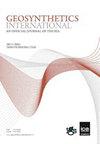Na-CMC 改性粘土:混合方法对水导率和聚合物洗脱的影响
IF 3.3
2区 工程技术
Q2 ENGINEERING, GEOLOGICAL
引用次数: 0
摘要
反应性土壤中因干燥而产生的裂缝会降低其机械强度,并增加其导水率(k)。聚合物添加剂在提高粘土的抗干燥开裂能力以及在暴露于盐溶液时保持低 k 值方面具有显著效果。然而,聚合物从处理过的混合物中洗脱的风险及其对增益耐久性的影响却很少受到关注。本研究评估了聚合物在重组混合物的固结和渗透过程中的浸出情况。通过湿法混合(WM)和干法混合(DM)将羧甲基纤维素钠(Na-CMC)加入 Na-膨润土中。利用热重(TGA)和总有机碳(TOC)分析法,对添加过和未添加过的样品进行了一系列 k 试验,以评估聚合物的保留和洗脱情况。在 DM 中加入 Na-CMC 可使 k 值降低约 60%。与 WM 相比,DM 表现出更高的聚合物浸出水平,随着时间的推移增加了渗透性。不过,尽管聚合物流失,但在长达 100 天的渗透过程中,DM 和 WM 试样的 k 值仍然低于未处理的膨润土。此外,在 DM 样品中引入缝隙薄膜土工织物作为沥滤的潜在补救措施,并不能显著提高聚合物的保留率。然而,它却降低了流出物中的聚合物含量,这表明可能是土工织物而不是膨润土保留了聚合物。本文章由计算机程序翻译,如有差异,请以英文原文为准。
Na-CMC-amended clay: effect of mixing method on hydraulic conductivity and polymer elution
Desiccation-induced cracks in reactive soils reduce their mechanical strength and increase their hydraulic conductivity (k). Polymer additives have demonstrated efficacy in improving resistance of clay against desiccation cracking and retaining low k when exposed to saline solutions. However, the risk of polymer elution from treated mixtures and its effect on the durability of gains have received little attention. This study evaluated polymer leaching during consolidation and permeation in reconstituted mixtures. Sodium carboxymethyl cellulose (Na-CMC) was added to Na-bentonite via wet mixing (WM) and dry mixing (DM). Conducting a series of k tests on amended and unamended samples, polymer retention and elution were assessed using thermogravimetric (TGA) and total organic carbon (TOC) analyses. Na-CMC incorporation under DM reduced k by approximately 60%. DM exhibited higher levels of polymer leaching compared to WM, increasing permeability over time. Nevertheless, despite polymer loss, k values for both DM and WM specimens remained lower than untreated bentonite for up to 100 days of permeation. Furthermore, introducing a slit-film geotextile as a potential remedy for leaching did not significantly enhance polymer retention in DM samples. However, it reduced the polymer content in the effluent, suggesting that the geotextile, not the bentonite, could have retained the polymer.
求助全文
通过发布文献求助,成功后即可免费获取论文全文。
去求助
来源期刊

Geosynthetics International
ENGINEERING, GEOLOGICAL-GEOSCIENCES, MULTIDISCIPLINARY
CiteScore
6.90
自引率
20.00%
发文量
91
审稿时长
>12 weeks
期刊介绍:
An online only, rapid publication journal, Geosynthetics International – an official journal of the International Geosynthetics Society (IGS) – publishes the best information on current geosynthetics technology in research, design innovation, new materials and construction practice.
Topics covered
The whole of geosynthetic materials (including natural fibre products) such as research, behaviour, performance analysis, testing, design, construction methods, case histories and field experience. Geosynthetics International is received by all members of the IGS as part of their membership, and is published in e-only format six times a year.
 求助内容:
求助内容: 应助结果提醒方式:
应助结果提醒方式:


